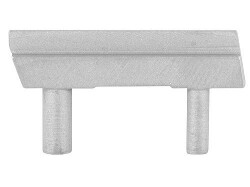
GI .45:

Long 45:
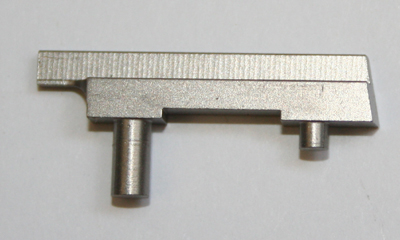
Long .38/9mm:
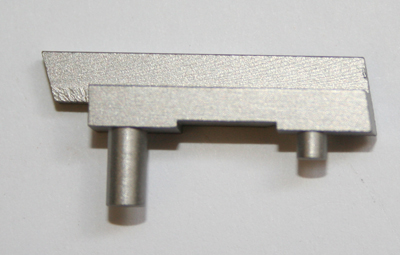
Extra Long 9mm:
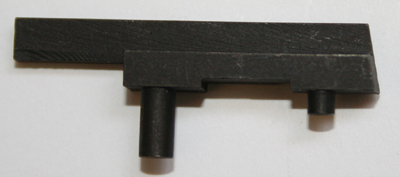
Can somebody explain the difference to me? I understand that by ejecting the casing sooner, it allows the the next round in the magazine to come up sooner (I suppose specifically the front of the round).
Also the angle of the front of the ejector, exactly what does it change?
The reason for my question is that I just got off the phone with Foster/Caspian to order parts for another 9mm build, and when I asked for a 9mm ejector, I was told that it was highly unusual to use the extra long one, which is what I used on the 9mm build I posted the other day, but rather that the "long .38" is the most common one for a 9mm build.
Finally, is there a proper tuning ejector tuning method?

That is not a picture of a GI ejector. The length's about right, but the nose shape is wrong. Here's a GI (M1911A1, U.S. Army issue) extractor (dang!) ejector:
Quote:
Can somebody explain the difference to me? I understand that by ejecting
the casing sooner, it allows the the next round in the magazine to come up
sooner (I suppose specifically the front of the round).
I've read that longer ejectors were developed for more reliable ejection of mid-range target ammunition. Because this stuff didn't get the slide moving back as fast, the spent case didn't always get out of the port. The longer ejector solved that problem by contacting the case while it (and the slide) were moving faster.
Quote:
Also the angle of the front of the ejector, exactly what does it
change?
It establishes the vertical position of the farthest-forward part of the ejector's nose and that's the part that the case first hits. The empty case being extracted is held in place prior to ejector contact by the extractor and left hand breechface guide block with the case head most probably not in contact with the breechface. So the case head can swivel a little about those two points of contact. Which way this swivelling can occur changes with ejector contact. And whether the ejector nose is shaped to provide the highest possible contact (as in your third photo) or the lowest possible contact (as in this)...
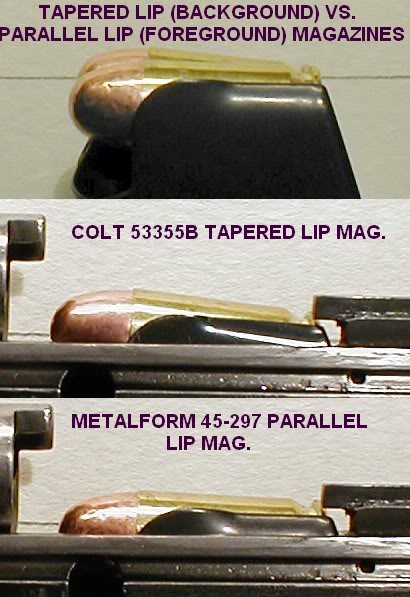
...determines which way the case mouth starts to move. And I've concluded (right or wrong) that how the case mouth initially moves determines how the empty case gets out of the slide. There's a lot of stuff involved here, and this may help "see" it:
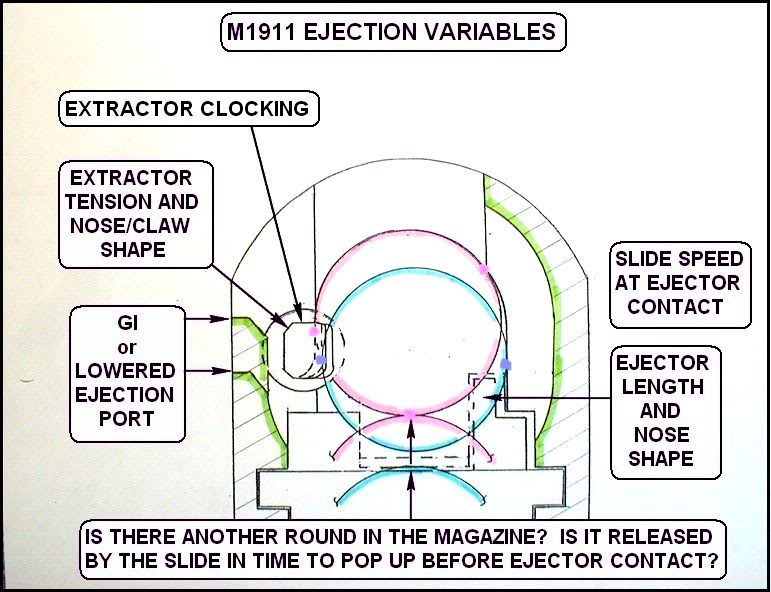
not.
Ahh... very good then.
Your pictures always have a way of explaining it to me.
Quote:
Can somebody explain the difference to me? I understand that by ejecting
the casing sooner, it allows the the next round in the magazine to come up
sooner (I suppose specifically the front of the round).
If I understand the timing correctly, with a standard length ejector the brass would already start ejecting before the slide is back far enough to let the next round up. If using an long ejector, the ejecting process happens earlier in the cycle ejecting brass sooner. The round still has time to come up otherwise it would short stroke. I suppose, this was intended to reduce possible malfunctions with race guns. Using a long ejector will not let you eject a live round. I'm pretty sure you know this but just in case it slipped your mind.
Quote:
Also the angle of the front of the ejector, exactly what does it
change?
It changes the direction in which the brass bounces out. The brass would have more of a tendency to deflect in the direction of the angle.
Quote:
Finally, is there a proper tuning ejector tuning method?
I don't know if there is a proper method. As I understand it there isn't any formula or measurement that is consistent from pistol to pistol caliber to caliber. What I do know is that if you standard or stock ejector isn't long enough to tune, you can of course purchase a long ejector and tune until you get it where you want with room for error.
I am by no means an expert on the matter. This is all to my understanding. Please correct me if I'm wrong.
The long ejector was introduced in the Commander, to make up for the shorter slide stroke. The slide continues to the rear about the same distance after case/ejector contact in both guns. A long ejector can make it difficult to eject live rounds, as the bullet hits the edge of the ejection port before it's clear. And, as noted, you lose the assist of the round rising in the mag if the case hits the ejector before the magwell is uncovered by the slide. For some reason, my Commander has a Government Model ejector, and it has ejected perfectly, except on the last round in the mag, in which case (pun) the extracted case occasionally falls off the extractor hook before it hits the ejector (which would seem to prove that the top round in the mag is indeed providing an ejection assist) and is left in lying in the port.
Rick, if the case is falling off the extractor before ejecting, I would assume that adding a little more tension might be a fix. Is this just something you personally have learned to live with or don't mind?
Quote:
If I understand the timing correctly, with a standard length ejector the
brass would already start ejecting before the slide is back far enough to let
the next round up.
I don't think so. I'm with RickB in believing with a standard GI (short) ejector, the next round in the magazine is uncovered by the disconnector rail and pops up before the empty case contacts the ejector.
This action stuffs each empty case up under the arch in the left hand breechface guide block as shown outlined in pink in the drawing. This uppermost position seems most favorable to good ejection as it helps the case mouth avoid contact (or too much contact) with the lower edge of the ejection port.
But the empty case from the last round in the magazine has no round below to pop up underneath it and shove it upward. So this last case is lower on the breechface (outlined in blue in the drawing), gets hit higher up by the ejector, the case mouth swivels more horizontally, hits more of the ports lower edge and often gets deflected straight up and back into the shooter's face.
At least (with no high speed video to show otherwise) that's how I've kind of got it figured out. Sounds good, huh?
Ejectors:
Well it is true that the extended ejector was developed for the Colt Commander, the Colt Commander was developed as a 9mm, and I believe it was for the 9mm, here's why:
The Commander slide is shorter as does not move as far back on the frame as compared to the GM, the difference is about .225 (corrected from.218) measured on my guns. The 9mm case being shorter and the Colt 9mm mag having a spacer in the back of it, the extended ejector was necessary.
I'm under the impression that the Commander /Combat Commander ejectors are the same regardless of caliber. The slides interchange, at least they did on my XS and XSE LWTs.
The side to side dimensions for the GM standard, the .38 Super , and the Commander ejectors are not the same. The Commander ejector and the .38 Super/10mm GM ejector are close and the slides will interchange. The GM .45 slide will not fit on either one.
I've also read on some occasions that the extended ejector was developed for the .38 Super, but I've never owned a Colt .38 Super, Commander or GM, with the extended ejector. My LWT XSE .38 Super doesn't have one.
I'm sure the Colt Series 70 MKIV 9mm Government Model pistol had an extended ejector.
Just some of my observations with the Colt pistols, I measured the difference at one time for a gunsmith article I wrote.
Add: The extra long ejector is made to be shortened accordingly IMO.
And just as an afterthought, don't forget about the "iffiness" of it all - even with the same gun, magazine, ammunition & shooter - things not mentioned in the last pic in Post #2:
* If there is another round in the magazine (just itching to pop up under the feed lips when uncovered by the disconnector rail) exactly where is that top round in the magazine fore-aft wise? If it's all the way aft it'll get uncovered and pop up as late as possible. If it's not all the way aft it'll pop up sooner.
* What about the gyrations the gun and shooter's hand/arm are doing after firing? Are they the same each time?
* What about ammunition where the case has a poor grip on the bullet, the bullet gets pushed back into the case by varying amounts when each round is fed and this causes fluctuations in case volumes, peak pressures, muzzle velocities and recoil impulses?
* What about... well, you get the idea. Just like feeding rounds into the chamber, getting the empties out of the gun is a bit... uh... complicated?
Quote:
I've read that longer ejectors were developed for more reliable ejection of
mid-range target ammunition.
So based on what other have said, this should be changed to say "The longer Commander ejector was found to improve ejection of low energy, mid-range target ammunition empties when installed in a full-sized, 5" 1911."
Take a look at the this video conducted by Tripp Research. The magazine is cut out and you could see the rounds move as the gun cycles. Unless my eyes are playing tricks on me, it appears as though the rounds are moving up after the brass starts ejecting.
EDIT: The action starts at 0:45
Quote:
Rick, if the case is falling off the extractor before ejecting, I would
assume that adding a little more tension might be a fix. Is this just
something you personally have learned to live with or don't mind?
It's something that I don't really notice. I use the gun in IDPA competition, and when reloading from slidelock, the empty case drops out along with the empty mag. But, I should put a little more tension on the extractor so that the gun runs properly under all conditions. I didn't want to tweak it "in the field", for fear of not getting it right and causing other problems.
Yeah, the Commander was developed from a compact 9mm pistol that Colt was peddling to the postwar military (as S&W did with the 39). I was trying to figure out why Colt had gone to the trouble of shortening the slide stroke of the Commander, rather than just cut 3/4" off the barrel/slide, and it would appear that Colt decided to not redesign the short-stroke aspect, developed for the shorter 9mm cartridge, when adapting it to .45. I have a pic of the prototype 9 from an old issue of G&A magazine, and other than the slide markings, it looks just like a pre-80 Combat Commander.
Quote:
I was trying to figure out why Colt had gone to the trouble of shortening
the slide stroke of the Commander, rather than just cut 3/4" off the
barrel/slide, and it would appear that Colt decided to not redesign the short-
stroke aspect, developed for the shorter 9mm cartridge, when adapting it to
.45.
I would speculate that during the War that the R&R Dept. did alot of things. They, Colt, may have discovered that the breach end of the 1911 slide didn't necessarily have to move as far during recoil to function properly.
The GM/ 1911 slide was designed for the breach face to clear the disconnector during recoil, and lock open behind the disconnector. It was apparently found to be unnecessary for the slide to lock open behind the disconnector. The difference of the rearward movement of the Commander slide; .225 as measured on my two guns plus; the 0.10 shorter slide rails gave Colt the needed space in front of the slide abuttment for the recoil spring assembly and a 3/4 inch shorter slide.
I'm sure alot was learned about autoloading pistols from the time that John Browning, Carl Ebherts, the engineers at Colt and the U.S. Ordnance developed the 1911 and 1949 when the Commander was introduced.
Quote:
Take a look at the this video conducted by Tripp Research. The magazine is
cut out and you could see the rounds move as the gun cycles. Unless my eyes
are playing tricks on me, it appears as though the rounds are moving up after
the brass starts ejecting.
My old eyes see the same thing.
But what style of ejector does the gun have?
Quote:
But what style of ejector does the gun have?
It does indeed seem to have an extended ejector (not an extra long... but an "extended").
I really like watching those videos... so much to learn and so much to watch at the same time.
Quote:
But what style of ejector does the gun have?
Hmm. Very good question. I intend to inquire.